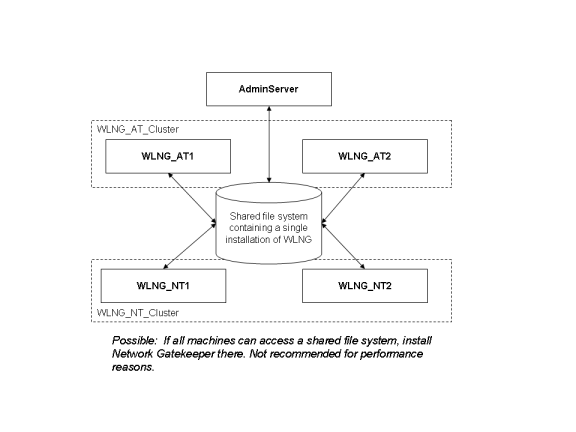







|
This chapter provides a high level description of the process of installing and configuring Oracle Communications Services Gatekeeper. Subsequent chapters describe the specific steps required to use each type of installation and configuration tools in detail.
Setting up Oracle Communications Services Gatekeeper is a four step process. You must:
Before you can install Oracle Communications Services Gatekeeper, you must gather a certain amount of information about your system. You need to know:
The files in the BEA Home directory are essential to ensuring that Oracle Communications software operates correctly on your system. They:
$BEAhome\ocsg_4.1.
Installing Oracle Communications Services Gatekeeper generally requires that three separate components be copied to your hardware:
Each of these components is copied to its appropriate places when you run the Oracle Communications Services Gatekeeper installer. There are three main installer modes available:
| Note: | If you want to run graphical-mode installation, the console attached to the machine on which you are installing the software must support a Java-based GUI. All consoles for Windows systems support Java-based GUIs, but not all consoles for UNIX/Linux systems do. If you attempt to start the installation program in graphical mode on a system that cannot support a graphical display, the installation program automatically starts console-mode installation. |
The specifics of each of these installers are covered in Installing Oracle Communications Services Gatekeeper. You need to do this for each machine in your installation.
| Note: | It is recommended that you install Oracle Communications Services Gatekeeper on the local disk of each server in your setup, as in Figure 5-1. |

If all of your servers can access a shared file system, it is possible to install Oracle Communications Services Gatekeeper only there (see Figure 5-2), but this is not recommended, for performance reasons.

Configuring the domain for WebLogic Server for use in Oracle Communications Services Gatekeeper installations can be accomplished using one of two available tools:
| Note: | If you want to run graphical-mode configuration, the console attached to the machine on which you are configuring the domain must support a Java-based GUI. All consoles for Windows systems support Java-based GUIs, but not all consoles for UNIX/Linux systems do. If you attempt to start the installation program in graphical mode on a system that cannot support a graphical display, the installation program automatically starts console-mode installation. |
| Note: | The WebLogic Scripting Tool (WLST) is a command-line scripting interface that system administrators and operators use to monitor and manage WebLogic Server instances and domains. The WLST scripting environment is based on the Java scripting interpreter, Jython. For more information on WLST, see Oracle WebLogic Server WebLogic Scripting Tool at http://download.oracle.com/docs/cd/E12840_01/wls/docs103/config_scripting/. |
Oracle Communications Services Gatekeeper ships with five default configuration templates:
These templates contain the basic information for setting up various common installation selections. However in all cases, some aspects of the domain may need to be adjusted during the domain configuring process. The entire process is covered in Configuring the Domain for Oracle Communications Services Gatekeeper.
Once installation is complete and your domain has been set up, you must:
These are covered in Completing Post-Installation.
To learn more about installing WebLogic Server products in general, and about the installer program in particular in regard to WebLogic Server, see Oracle WebLogic Server Installation Guide at http://download.oracle.com/docs/cd/E12840_01/common/docs103/install/index.html.


|